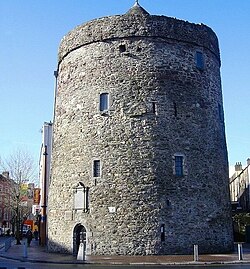Reginald's Tower
| Reginald's Tower | |
|---|---|
Túr Raghnaill | |
 Reginald's Tower in Waterford, Ireland | |
| General information | |
| Type | Fortified tower |
| Town or city | Waterford |
| Country | Ireland |
| Coordinates | 52°15′37.5″N 7°6′19.5″W / 52.260417°N 7.105417°W |
| Renovated | 13th–14th century |
| Height | 54 ft |
| Dimensions | |
| Diameter | 42½ ft |
| Technical details | |
| Material | Stone |
| Official name | Reginald's Tower |
| Reference no. | 661[1] |
Reginald's Tower (
Early history
Reginald's Tower was built by the
The tower is 54 feet high; its horizontal cross section is circular. It is 42½ feet in diameter and is surmounted by a conical roof. A spiral staircase ascends within the thick walls - these are 10 feet wide at the base, tapering down to 7 feet at the top. It was part of the ancient city walls of Waterford and could be considered the apex of a triangle formed by three structures — Turgesius Tower on Barronstrand Street, St. Martins Castle on Lady Lane, and Reginald’s Tower at the quay and the mall.[7] It was strategically located on the high ground between a branch of St. John's River on the southeast (since drained, and now known as the Mall) and the River Suir to the north. It is also very close to the historic French Church. The site is sometimes called Dundory (an Irish word which means "fort of oak"), and hence the tower is occasionally called the Dundory Tower. It is also known as the Ring Tower.[5] It was one of seventeen towers which encircled the city of Waterford in medieval times. Today it is the largest of the six surviving towers, which are considered the finest examples of medieval urban defence in Ireland.[6] The other surviving towers are the Watch Tower, Double Tower, French Tower, Semi-Lunar Tower and Beach Tower.[8]
Medieval history
The tower has been used as a
In 1463, coins were minted in Reginald's Tower by order of the Irish Parliament, which, at that time, was meeting in the city. The coins had the words "Civitas Waterford" struck on one side. In 1495, the tower’s cannons successfully deterred the forces of Perkin Warbeck, the pretender to the throne of Henry VII. Cannons from the tower sank one of his ships during an 11-day siege. This was the first successful use of artillery by an Irish city. A cannon from this ship was recovered from the River Suir in 1901.[6] This victory earned the city its motto Urbs Intacta Manet - "Waterford remains the unconquered city".[10]
In 1649, Waterford was besieged by the army of the English parliamentarian Oliver Cromwell, but he failed to capture the city on that occasion. They returned in 1650, and this time they were successful. A cannonball, visible high up the wall on the north side of the building, is lodged firmly in the wall, and is reputed to be from this siege.[11]
In 1690, following his defeat at the Battle of the Boyne, James II of England is said to have climbed to the top of the tower to take a last look at his lost kingdom before embarking for exile in France.[12]
During the 17th and 18th centuries, the tower was used to store munitions. In the early 19th century it functioned as a prison.[13]
Present day

In 1861, Reginald's Tower became the property of the Waterford Corporation,
It is located in the area of Waterford Viking Triangle in the centre of Waterford city. A replica Viking longship is exhibited beside Reginald's Tower.
See also
- List of National Monuments in County Waterford
- History of Waterford
References
- ^ "National Monuments of County Waterford in State Care" (PDF). heritageireland.ie. National Monument Service. p. 2. Retrieved 12 July 2020.
- ISBN 9780862786564.
- ^ Wilson 2014, p. 30.
- ^ Halpin & Newman 2006, p. 490.
- ^ a b J.S. Carroll, Decies Journal XXVI Summer 1984. pp.22–27
- ^ a b c d e Reginald's Tower, visitors guide, Office of Public Works
- ^ Smith 1746, p. 166.
- ^ McEneaney 2001, pp. 96–104.
- ^ Power 1933, p. 20.
- ^ Power 1933, p. 44.
- ^ a b Walsh 1968, p. 13.
- ^ a b McEneaney 2001, p. 72.
- ^ "Reginald's Tower". Prison History. Retrieved 26 July 2023.
- ^ Walsh 1968, p. 14.
Bibliography
- Smith, Charles (1746). The Ancient and Present State of the County and City of Waterford.
- Power, Patrick C.(1933). A Short History of County Waterford.
- McEneaney, Éamonn (2001). Discover Waterford. O'Brien Press. ISBN 9780862786564.
- Halpin, A; Newman, C (2006). Ireland: An Oxford Archaeological Guide to Sites from Earliest Times to AD 1600. Oxford Archaeological Guides. Oxford: ISBN 978-0-19-280671-0.
- Walsh, Joseph J. (1968). Waterford's Yesterdays and Tomorrows and an Outline of Waterford History. Munster Express. ISBN 9780950205618.
- Wilson, A (2014). Birkett, T; Lee, C (eds.). The Vikings in Munster (PDF). Languages, Myths and Finds (series vol. 3). Centre for the Study of the Viking Age, University of Nottingham. pp. 20–32. ISBN 9780853583004.

